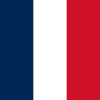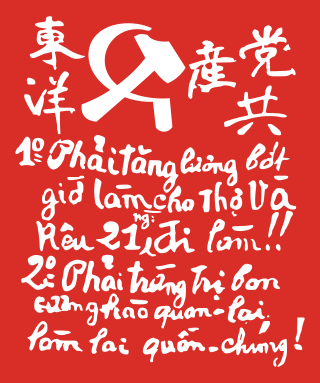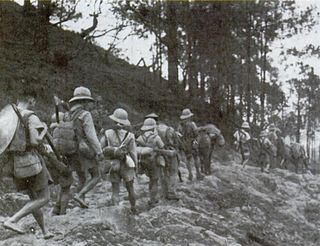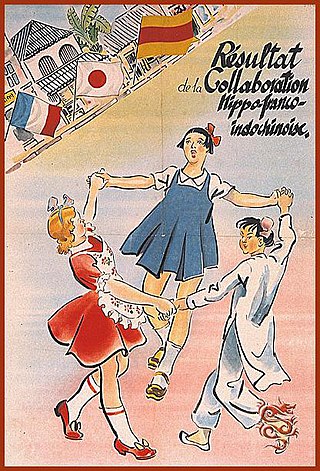
The following is a list of flags of French Indochina from 18 February 1859 to 9 March 1945. [1] [2]

The following is a list of flags of French Indochina from 18 February 1859 to 9 March 1945. [1] [2]
| Flag | Date | Use | Description |
|---|---|---|---|
 | 17 October 1887 to 9 March 1945 | State flag and civil ensign | A tricolour flag featuring three vertical bands coloured blue (hoist side), white, and red (2:3). |
 | 1867 – 9 March 1945 | Flag of the governor colony | A vertical tricolour of blue, white, and red on swallow tail blue ensign (1:2). Influences: |
 | 1923–1945 | Civil and naval ensign of French Indochina | A vertical tricolour of blue, white and red on swallow tail yellow ensign. (proportions 1:2). Influences: |
| Flag | Date | Use | Description |
|---|---|---|---|
 | 1862 – 9 March 1945 | War flag | A vertical tricolour of blue, white, and red (proportions 1:1). Influences: |
 | 1923 – 9 March 1945 | Flag of Tirailleurs indochinois | French flag canton on a yellow field (1:1). Influences: |
 | 1867 – 9 March 1945 | Flag of Gendarmerie | Influences: |
| Flag | Date | Use | Description |
|---|---|---|---|
 | 1858–1885 | Diplomatic flag of Dainamese empire [3] | Yellow field with gold border (2:3). |
 | 1885–1890 | Provisional flag of Dainamese empire | National name centered on the yellow field (2:3). Influences: |
 | 1923 – 9 March 1945 | Protectorate flag of Annam, Tonkin and Kouang-Tchéou-Wan | French flag canton on a yellow field (2:3). Influences: |
| Imperial standards | |||
| Flag | Date | Use | Description |
 | 1885–1890 | Nguyễn dynasty by Cảnh Tôn | Standard of Dainamese emperor, beside, used as the [provisional] national flag. Influences: |
 | 1890–1920 | Nguyễn dynasty from Thành Thái to Hoằng Tôn | A yellow field with a single red stripe. The flag of dragon and star, originally designed by Emperor Thành Thái. [4] [5] [6] Highly same as the Spanish flag. Influences: |
 | 1920 – 8 May 1945 | Nguyễn dynasty from Hoằng Tôn to Bảo Đại | The flag of dragon and star, used as the [official] national flag in 1945. Influences: |
| Personal standards of emperors | |||
| Flag | Date | Use | Description |
| | 1802–1945 | [Triangle] Personal standard of emperors of Nguyễn dynasty | The flag of yellow and dragon (黃龍旗 / Hoàng-long kì) or emperor (天子旗 / Thiên-tử kì). Flag ratio is 1:2. |
 | 1922–1945 | [Rectangle] Personal standard of emperors of Nguyễn dynasty (Hoằng Tôn and Bảo Đại) | Flag ratio is 2:3. Influences: |
 | 1802–1945 | Imperial pennon of Nguyễn dynasty | Flag ratio is 5:3. |
| Flag | Date | Use | Description |
|---|---|---|---|
 | 1713–1947 | National and royal flag of Kingdom of Champasak | |
 | 1707–1893 | National and royal flag of Kingdom of Luang Phrabang | |
 | 1887–1945 | Protectorate flag of Kingdom of Laos | Influences: |
 | 1887–1975 | Royal standard of the Kingdom of Laos | Influences: |
| Flag | Date | Use | Description |
|---|---|---|---|
 | 1863–1948 | Protectorate flag from Norodom to Sihanouk | Similar flag to the present flag, but instead of 2 blue bands above and bottom, it was a dark blue banner and a small red banner inside. |
 | 1863–1993 | Royal and personal standard of the King | Red flag with a dark blue rectangle inside, with elements from the Royal Arms of Cambodia in gold. |
| Flag | Date | Use | Description |
|---|---|---|---|
 | 1862–1945 | Flag of France. | After becoming autonomous republic in 1946, Cochinchina adopted a yellow flag with three blue strips. |

French Indochina, officially known as the Indochinese Union and after 1947 as the Indochinese Federation, was a grouping of French colonial territories in Southeast Asia until its demise in 1954. It comprised Cambodia, Laos, the Chinese territory of Guangzhouwan, and the Vietnamese regions of Tonkin in the north, Annam in the centre, and Cochinchina in the south. The capital for most of its history (1902–1945) was Hanoi; Saigon was the capital from 1887 to 1902 and again from 1945 to 1954.

The Việt Minh was a national independence coalition formed at Pác Bó by Hồ Chí Minh on 19 May 1941. Also known as the Việt Minh Front, it was created by the Indochinese Communist Party as a national united front to achieve the independence of the Democratic Republic of Vietnam.
The Indochina Wars were a series of wars which were waged in Southeast Asia from 1946 to 1992, by communist Indochinese forces against the opponents. The term "Indochina" originally referred to French Indochina, which included the current states of Vietnam, Laos, and Cambodia. In current usage, it applies largely to a geographic region, rather than to a political area. The wars included:

At the present time, there is no known Scouting program in Laos, one of only four of the world's independent countries that do not have Scouting.

The Indochinese Communist Party (ICP) was a political party which was transformed from the old Vietnamese Communist Party in October 1930. This party dissolved itself on 11 November 1945.

The French protectorate of Laos was a French protectorate in Southeast Asia of what is today Laos between 1893 and 1953—with a brief interregnum as a Japanese puppet state in 1945—which constituted part of French Indochina. It was established over the Siamese vassal, the Kingdom of Luang Phrabang, following the Franco-Siamese War in 1893. It was integrated into French Indochina and in the following years further Siamese vassals, the Principality of Phuan and Kingdom of Champasak, were annexed into it in 1899 and 1904, respectively.

French Cochinchina was a colony of French Indochina, encompassing the whole region of Lower Cochinchina or Southern Vietnam from 1862 to 1946. The French operated a plantation economy whose primary strategic product was rubber.

The Empire of Vietnam was a short-lived puppet state of Imperial Japan governing the former French protectorates of Annam and Tonkin between March 11 and August 25, 1945. At the end of its rule, the empire also successfully reclaimed Cochinchina as part of Vietnam.

The Japanese coup d'état in French Indochina, known as Meigō Sakusen, was a Japanese operation that took place on 9 March 1945, towards the end of World War II. With Japanese forces losing the war and the threat of an Allied invasion of Indochina imminent, the Japanese were concerned about an uprising against them by French colonial forces.

Trần Trọng Kim, courtesy name Lệ Thần, was a Vietnamese scholar and politician who served as the Prime Minister of the short-lived Empire of Vietnam, a state established with the support of Imperial Japan in 1945 after Japan had seized direct control of Vietnam from Vichy France toward the end of World War II. He was an uncle of Bùi Diễm.

The Fédération Indochinoise des Associations du Scoutisme was the earliest Scouting governing body in French Indochina, encompassing several smaller Cambodian, Laotian, and Vietnamese Scout associations, open without bias of faith or political viewpoint, from 1930 to 1954. The federation spawned, then later devolved into, the Scouts Lao, the Hội Hướng Đạo Việt Nam and the Angkar Khemarak Kayarith.

North Vietnam, officially the Democratic Republic of Vietnam, was a socialist state in Southeast Asia that existed from 1945 to 1976, with formal sovereignty being fully recognized in 1954. A member of the Eastern Bloc, it opposed the French-backed State of Vietnam and later the Western-allied Republic of Vietnam. North Vietnam emerged victorious over South Vietnam in 1975 and ceased to exist the following year when it unified with the south to become the current Socialist Republic of Vietnam.
The following is a list of political organizations and armed forces in Vietnam, since 1912:

In mid-1940, Nazi Germany rapidly defeated the French Third Republic, and the colonial administration of French Indochina passed to the French State. Many concessions were granted to the Nazi-allied Empire of Japan, such as the use of ports, airfields, and railroads. Japanese troops first entered parts of Indochina in September 1940, and by July 1941 Japan had extended its control over the whole of French Indochina. The United States, concerned by Japanese expansion, started putting embargoes on exports of steel and oil to Japan from July 1940. The desire to escape these embargoes and to become self-sufficient in resources ultimately contributed to Japan's decision to attack on December 7, 1941, the British Empire and simultaneously the USA. This led to the USA declaring war against Japan on December 8, 1941. The US then joined the side of the British Empire, at war with Germany since 1939, and its existing allies in the fight against the Axis powers.
The Communist League of Indochina was one of the three communist groups of 1929–1930 which formed the base of the Communist Party of Vietnam in Vietnam, and within colonial French Indochina. It was formerly the Tân Việt Cách mệnh Đảng as well as the "Restoration Society" between 1925 and 1930.

Tonkin, or Bắc Kỳ (北圻), was a French protectorate encompassing modern Northern Vietnam. Like the French protectorate of Annam, Tonkin was still nominally ruled by the Nguyễn dynasty, but in 1886, the French separated Tonkin from the Nguyễn imperial court in Huế by establishing the office of "Viceroy". However, on 26 July 1897, the position of Viceroy was abolished, officially making the French resident-superior of Tonkin both the representative of the French colonial administration and the Nguyễn dynasty court in Huế, giving him the power to appoint local mandarins. In 1887, Tonkin became a part of the Union of Indochina.

The Cambodia–Vietnam border is the international border between the territory of Cambodia and Vietnam. The border is 1,158 km in length and runs from the tripoint with Laos in the north to Gulf of Thailand in the south.

The Montagnard country of South Indochina, sometimes abbreviated as PMSI, was an autonomous territory of French Indochina, and an autonomous federation within the French Union, created in 1946 following the French reconquest of the Cao nguyên Trung bộ from the Democratic Republic of Vietnam during the First Indochina War. The territory was supposed to be an autonomous homeland of the Montagnard people within French Indochina, but existed mainly to serve French colonial interests in the region.
The Institut d'Émission des États du Cambodge, du Laos et du Viet-nam, also known as the Institut d'Émission des États Associés, was a short-lived currency board operating in French Indochina in 1952–1954.
{{cite book}}: CS1 maint: location missing publisher (link)